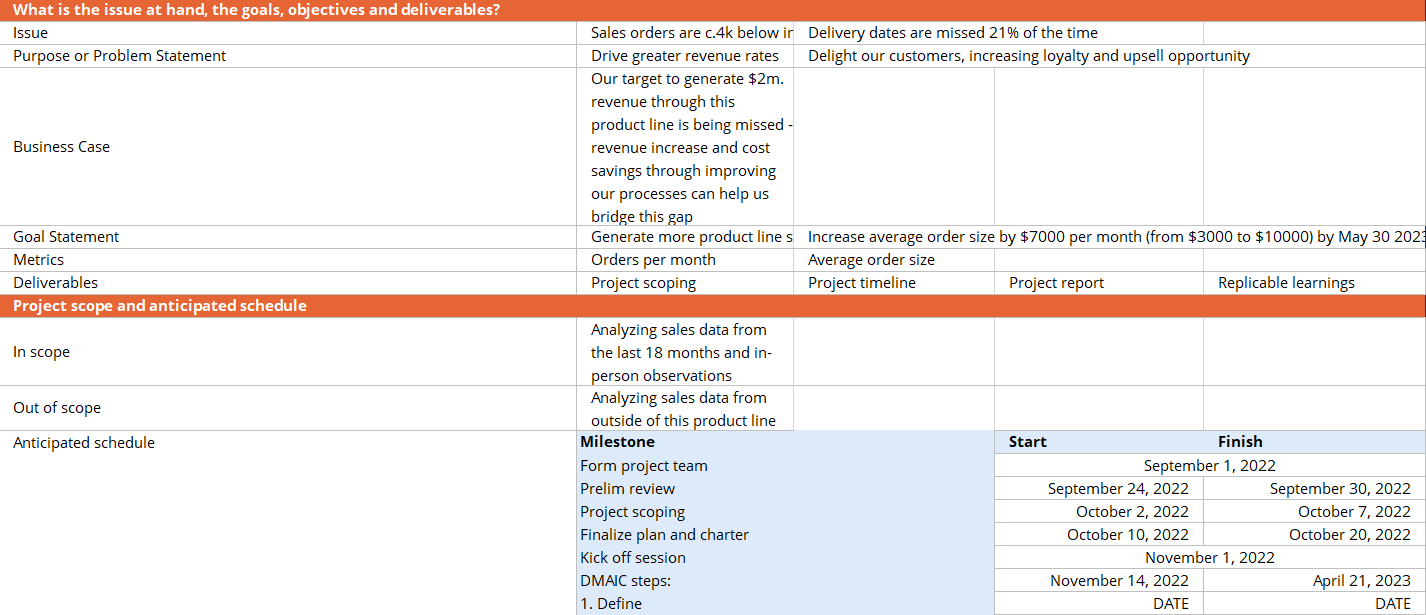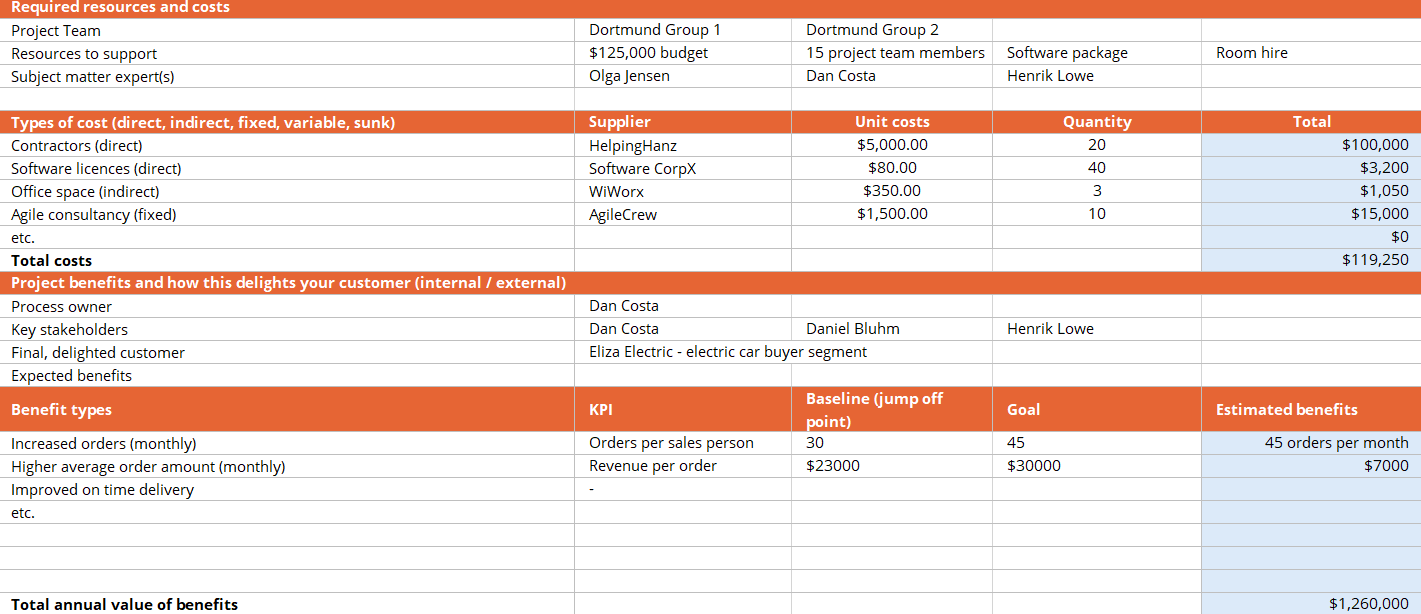While the humble project charter has long been a staple in PMOs, the cracks start to appear when tackling enterprise portfolios. Here's why.
Written by: James Milsom, Head of Marketing
What is a project without a sense of purpose? Without a purpose, what we believe to be a project is nothing more than a collection of actions that, no matter our hopes, amount to a random collection of outcomes at best.
Enter the humble project charter.
When ideas are seeded and look to be brought to life, it is the project charter that provides the soil in which the idea can develop into a blossoming flower. Collecting project goals, scope, roles, metrics, stakeholders, and more, it is here where the project begins.
But what happens when the project charter lives in isolation from reality? Tucked away in a OneDrive, disconnected from not only your portfolio but the wider program and corporate strategy which, ultimately, it should serve?
The cracks begin.
Take poor scheduling of the project, incomplete resource forecasting, and add in a multiplier effect across the whole organization, and you can quickly appreciate that a project charter needs to be adapted, digitalized, and connected to a whole world of moving parts for it to succeed at an enterprise level.
Collaboration, visibility, and best practice are the answer to raising the quality and effectiveness of your project charters, and this blog runs through the different project charter elements, and how you can transform your approach.
Remembering the purpose of your charter
What should the project charter cover?
Whether this is your first project charter or your thousandth, let’s begin by reminding ourselves of the purpose of your project.
This short, formal document is part of the PM toolkit, designed to help you articulate, define, and present to stakeholders how this effort will support the realization of your portfolio goals, and the wider corporate strategy.
The outline of the project charter will look similar to the below project charter example:

Within you’ll find:
- An explanation of why the project is needed, establishing clarity of purpose from the start
- Detailed objectives, ensuring there are clear targets and milestones to work towards in the project
- Anticipated constraints in delivering the objectives and how you plan to overcome and monitor
- The key stakeholders, meaning you can build out an engagement plan to communicate and deliver value in their eyes
- Scoping of the project’s boundaries, including basics around the start and end date, items to be addressed, and fringe items which will not be addressed
- The potential risks in your project, giving a view to all potential risks that may appear in the delivery of the work, accompanied by a risk register and management plan to assign owners and actions for overcoming these hurdles should they appear
- Anticipated benefits of delivering the project should be provided, tailored to sponsors, stakeholders, and those that feed into objectives beyond this project
- Project costs which lead to a budget, a rough estimate of the cost in delivering the project, and who is the budget holder
Moving beyond the description of the project, any good project charter will include additional information like the below:
- Project Sponsor
- Project Manager
- Contact details
- Organizational Unit
- Processes Impacted
- Business Case
- Tentative Schedule
- Project Team

After this, the charter will cover off the resource, costs and benefits, as below:
- Support Resource
- Labor Costs
- Technology Costs
- Final Customer
- Type of Benefits (savings, revenue, productivity, compliance, etc.)

This view of the project is the starting point for all that follows, making it a vital piece to get right and, where possible, apply a best practice approach, such as DMAIC, should you be following Lean Six Sigma model.
What are the benefits of creating a project charter?
With a project charter laid out, some of the issues it helps with includes:
1) Establishing the importance of the work
Within the project charter, you are able to cover off any questions which relate to the ‘why are we doing this work?’ question.
Whether it is anticipated benefits in general terms, or tying the work into the 8 Lean Wastes, a practitioner or department head should be able to pick up the charter and know, clearly, the importance of the work to the organization
2) Bridging the gap between the project plan and project delivery
Your charter is a guide to what you want to achieve, how you seek to achieve it, and by when. Better yet, it helps you to anticipate possible problems, or, whilst drafting, it can help you to think critically about the true value of the project.
In any case, you’ll be able to foresee potential challenges and bottlenecks through the project lifecycle.
3) Giving structure and rigor to your work
There’s no escaping the reality that a project charter is a well-established way to lay out the work that you want to complete, and much more.
Whether it’s used as a means to give focus to your stakeholders and team, or detailing the ROI of the effort based on budget and expected benefits in quantifiable terms like cost reductions or on-time deliveries, the structure of a project charter lends a certain rigor to your work.
4) Building a learning culture
When your team is able to point towards previous charters as examples of best practices, your business is ever-learning.
When you add in the internal subject matter experts who are involved in projects, as well as an improved estimation of benefits, costs, and risk, you can begin to establish your own culture of improvement.
One project no longer sits in isolation. You can drive repeatable, sustainable gains from one project into another where there is a fit.
While you could go about creating your own Excel or Word-based project charter, there are many templates available to Project Managers. Download any of the below:
However, it is with these very Excel and Word project charter templates that we begin to see the cracks…
3 enterprise challenges of project charters
The essence of the below challenges is that the project charter is inefficient when work and improvement efforts are being conducted across an entire organization.
All too often you may find yourself asking if the project laid out in the document is contributing to your portfolio, or, when your team is spread across multiple plants, divisions, and continents, whether they are adhering to your best practice when creating one.
These are the common challenges that form for PMOs when creating and governing project charters at an enterprise level.
No common practice to govern the creation
The root of this challenge is coordination. When project charters are formed in isolation from what you consider to be your best-practice templates and toolkits, inevitably the project charter will suffer.
From poorly defining its purpose to not using supporting tools such as your budget and stakeholder engagement plans, you will quickly find that project success rates become a patchwork quilt.
This, in turn, only serves to damage your daily efforts, as well as the wide improvement program you will be running, pushing you even further away from achieving business excellence.
While traditional Excel and Word templates, as well as project management software, are useful for governing your best practice and usage of your toolkit, when you multiply the sheer number of projects being created across an entire enterprise, it can be overwhelming.
Multiple software packages, different storage preferences (desktop v OneDrive v SharePoint v Google Drive, the list goes on), and a general lack of coordination, means that the very first step of your project could be a slip.
The benefit of creating a common project charter practice is clear – with those who establish practices saving 28 times more money than those without.
For those organizations regarded as being Project Management Technology Quotient by PMI (i.e. able to align PMO to corporate strategy, coordinate organization-wide projects, and adapt to constant change) over 70% have processes to mature their existing practices.
While your mantra may be to lead from the front, without finding an enterprise solution to embed, govern, and mature best practice when it comes to project charters, your activities will seldom deliver the value and efficiencies you want.
The project doesn’t serve the portfolio or corporate strategy
Continuing the theme of coordination - without guiding the creation of project charters, how can you be sure that the project will serve its portfolio, or indeed the wider corporate strategy?
While stage gates do serve to align the project to its charter-defined purpose, they provide limited value should the project be poorly defined and aligned to business objectives at its inception.
A solution to this challenge may be to introduce a sign-off process whereby you, as the Head of Excellence, or a similar role, review each charter before their submission. However, this can introduce all-consuming administration and paperwork and is far from efficient.
So, we turn to technology. By using software such as i-nexus, you can manage your portfolio from one location, ensuring that project charters are created in the same area where useful information about corporate strategy, themes, and portfolios sit.
With this, you can ensure your project charters are not only following your best practice in terms of the standard details covered above but so too can it serve to plug the inevitable gaps that form when strategy execution and operational excellence sit apart.
That's a gap that enterprise PMOs know all too well, with only 41% reporting alignment to business strategy.
But, as Alsudiri et. al show, those organizations who have strong alignment between corporate strategy and project management show higher achievement rates of their stated project goals.
Poor resource forecasting and scheduling conflicts
How can you streamline project creation, thereby driving more value from improvement activities, without a full appreciation of resource challenges such as employee churn, illness, and scheduling conflicts?
The success of your project will be largely impacted by the available capital, capacity, and competing priorities across your portfolio.
Creating a project in a smaller organization is more straightforward in some ways due to the lesser number of moving parts to consider when forecasting available resources.
However, when you operate within a mature PMO, running hundreds of projects at any one time, and where your operational excellence experts are helping Transformation teams deliver corporate strategy, soon you run into frequent obstacles.
Does your Project Manager know of available resources, or those staff who are going through their training to level up to the green or black belt, without having to jump between systems, documents, and Zoom calls?
Enterprise-scale organizations will run into these issues due to their sheer size. You’ll often find yourself asking how you can be more efficient with managing these resources or even simply being able to improve how you plan for utilizing resources.
Without real-time information and visibility of resource deployment across the organization, your project charters are bound to miscalculate the support available to deliver the work.
The consequences? Lack of resources. Limited buy-in of leadership. Burn out.
Overcoming this challenge requires a system that helps you to identify bottlenecks, dependencies, and work across the organization which will, inevitably, impact the creation of your project charter.
Presenting a more efficient way
What emerges from these challenges is a clear need for a solution that unifies the entire organization.
The risks of poor visibility, collaboration, alignment, best practice, and resource shortages are greatly minimized by using an enterprise-wide software solution such as i-nexus.
The project charter is only one cog in the wider excellence machine that you are building. Ensuring projects are well defined, scoped, and utilize your resources to full capacity is crucial to leading into the bigger picture of embedding an improvement culture across the organization.
Molded around your best practices and process, with i-nexus software Heads of Business Excellence, Lean and Improvement are able to confidently answer the simple questions of how each project contributes to their business-critical goals.
But without an enterprise tool such as i-nexus to help govern your project charters, and indeed your entire portfolio of improvement projects, your projects will continue to run into the same obstacles.
Learn more about Project Management & Program and Portfolio Management
Click here to learn more about continuous improvement or take a look at these content recommendations:
- Leading Strategy Execution: Strategy Execution comes with great responsibilities and that calls for an even greater leader. Strategic leaders are the captain of your organizational ship and this is why they are central to the vessel’s journey.
- Harnessing the Voice of the Customer: Here’s why breaking through your performance barriers starts with your customer's voice.
- Help your business become Agile: Discover why an adaptive approach to strategic planning and execution begins with Operational Excellence.
About the author
James Milsom is Head of Marketing at i-nexus. James has wide-ranging experience in markets such as telecommunications, energy, education and software.
As Head of Marketing, his drive is to raise awareness and understanding of the challenges facing enterprises in delivering strategic objectives and transformation amidst changing markets and the obstacles traditional tools and methods present leaders.
If you’d like to talk more about Strategy Execution, reach out to James on james.milsom@i-nexus.com or connect with him on LinkedIn for the latest insights.





.jpg?width=352&name=seminar-594125_1920%20(1).jpg)